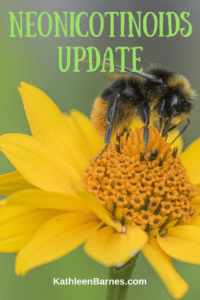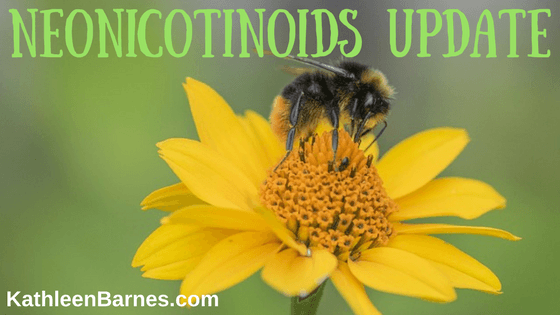 I’ve written several times about neonicotinoids, the insecticides that play a major role in the decline of bee colonies in the United States, potentially disrupting and even destroying the pollination cycle upon which our food supply is dependent.
I’ve written several times about neonicotinoids, the insecticides that play a major role in the decline of bee colonies in the United States, potentially disrupting and even destroying the pollination cycle upon which our food supply is dependent.
Yes, my friend, this is serious. Very serious.
Now, since we are entering the gardening season, it’s time for an update.
Neonics, as they are commonly called, are a relatively new form of synthetic insecticide in use for about the last 20 years. They are a chemical family based on nicotine like that found in tobacco and nightshade plants like tomatoes, eggplants, potatoes and peppers.
Neonics affect the central nervous system of insects, contributing to bee colony collapse disorder, and exposure is highly toxic to bees and almost always fatal to honey bees. Recent research shows that neonics are extremely toxic to wild bees and butterflies.
A 2014 Harvard study linked neonics to bee colony collapse disorder, but also implicated mite infestations and insufficient food supply.
Two years ago, the US Environmental Protection Agency issued a “preliminary risk assessment” warning that a neonic called imidacloprid could be endangering bee colonies and issued a moratorium on licensing new neonic products, although there are already plenty on the market for home and commercial use.
Awareness of the toxicity of neonics came to a sharp point in 2014 when 50,000 bees died in a Target parking lot in Wilsonvile, OR after being sprayed with a pesticide containing the neonic dinotefuran.
In any case, my advice is to avoid neonics as insect control products and don’t buy plants that have been treated with neonics to avoid endangering your local bee colonies.
Neonics are largely sold under Bayer and Ortho, but home-use products are also sold under other brand names. If a product contains imidacloprid, clothianidin, thiamethoxam, acetamiprid or dinotefuran it is a neonicotinoid. Please don’t buy it. Even the tiniest amount, in parts per billion, can kill bees.
Neonics are commonly applied to commercial plant crops, especially those sold at big box stores like Lowe’s, Home Depot and Walmart, which account for a large share of plants sold nationwide.
That’s why I’ve advocated against buying plants at these three chains as well as from supermarkets, which probably buy their plant stock from the same regional sources.
There has been a little light at the end of the neonic dark tunnel in the past couple of years.
Home Depot now requires a label on the pots of any plant treated with neonics and has announced it will phase out all suppliers who use neonics by the end of this year.
Lowe’s says it is working with growers to reduce neonics and has pledged to phase out neonics by 2019.
A year ago, Walmart announced that neonics had been eliminated form 80% of its garden plants and has eliminated almost all neonics home-use insecticides from its shelves.
True Value hardware, another major plant retailer, also announced it would stop selling neonic insecticides and would “collaborate with
growers to stop their use.
That means that neonics are very much present in the plants on sale right now.
THE BOTTOM LINE on Neonicotinoids:
I’m a plant addict and tend to buy way more than I need.
Buy local and ask a lot of questions! Most local growers make personal appearances at farmers markets. You can ask their policies and beware before buying. It’s also a good time to educate growers if they aren’t already educated about the dangers of neonics.
Home Depot would be a far distant second choice since pots should be labeled this spring. My nearest Home Depot is 25 miles away, so I haven’t yet checked out the presence of those plant labels, but I’d appreciate hearing any of you who can do this legwork for me.
And if you’re shopping at Lowe’s, Walmart or True Value, ask questions of the staff. I wouldn’t be surprised if they don’t know the answers, so please go up the food chain to the manager or even higher to express your concern and get correct answers.
Other articles on Neonicotinoids from Kathleen:







